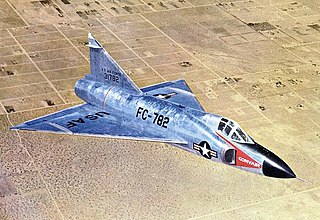
The Convair F-102 Delta Dagger was an American interceptor aircraft that was built as part of the backbone of the United States Air Force's air defenses in the late 1950s. Entering service in 1956, its main purpose was to intercept invading Soviet strategic bomber fleets during the Cold War. Designed and manufactured by Convair, 1,000 F-102s were built.

Quartier La Horie is a French Army base. It is located in the Moselle département, about 2 miles(3 km) west of the town of Phalsbourg, on the north side of the Route nationale 4 (N4) Highway adjacent to the village Saint-Jean-Kourtzerode; 29 miles (47 km) northwest of Strasbourg.

The 51st Fighter Wing is a wing of the United States Air Force and the host unit at Osan Air Base, South Korea. The wing has been based entirely in the Far East during its entire existence, including its combat role as the 51st Fighter-Interceptor Wing during the Korean War.

Erding Air Base is a German Air Force airfield near the town of Erding, about 45 kilometers (28 mi) northeast of central Munich in Bavaria. It is the home of the 5th Air Defense Missile Squadron and the 1st Air Force Maintenance Regiment.

Torrejón Air Base is both a major Spanish Air Force base and the co-located Madrid–Torrejón Airport, a secondary civilian airport for the city and metropolitan area of Madrid.

The 406th Air Expeditionary Wing is a provisional unit assigned to the United States Air Forces in Europe.

The 86th Airlift Wing is a United States Air Force wing, currently assigned to the United States Air Forces in Europe. The 86th AW is stationed at Ramstein Air Base, Germany.

The 134th Air Refueling Wing is a unit of the Tennessee Air National Guard, stationed at McGhee Tyson Air National Guard Base, Knoxville, Tennessee. If activated for federal service, the Wing is gained by the United States Air Force Air Mobility Command. The 134th Air Refueling Wing's KC-135 mission is to provide air refueling and airlift, as directed by the Secretary of Defense. It has been stationed at McGhee Tyson Airport since December 1957, though the ANG facility at the airport has been redesignated several times. Their radio callsign is "Soda"

The 176th Fighter Squadron is a unit of the Wisconsin Air National Guard 115th Fighter Wing located at Truax Field Air National Guard Base, Madison, Wisconsin. The 176th is equipped with the F-16 Fighting Falcon.

The 317th Fighter Interceptor Squadron is an inactive United States Air Force unit, last assigned to Aerospace Defense Command, being stationed at Elmendorf Air Force Base, Alaska, where it was inactivated on 31 December 1969.

The 331st Fighter-Interceptor Squadron is an inactive United States Air Force unit. Its last assignment was with Air Defense Command at Webb Air Force Base, Texas, where it was inactivated on 1 March 1967.

The 329th Fighter-Interceptor Squadron is an inactive United States Air Force unit. Its last assignment was with Los Angeles Air Defense Sector at George Air Force Base, California, where it was inactivated on 1 July 1967.

The 526th Fighter Squadron is an inactive United States Air Force unit. Its last assignment was with the 86th Operations Group, based at Ramstein Air Base, Germany. It was inactivated on 1 July 1994.

The 4730th Air Defense Group is a discontinued United States Air Force organization. Its last assignment was with the New York Air Defense Sector at McGuire Air Force Base, New Jersey, where it was discontinued in 1959.

The Spokane Air Defense Sector (SPADS) is an inactive United States Air Force organization. Its last assignment was with the Air Defense Command 25th Air Division at Larson Air Force Base in Grant County, Washington

The Detroit Air Defense Sector (DEADS) is an inactive United States Air Force organization. Its last assignment was with the Air Defense Command (ADC) 26th Air Division at Custer Air Force Station (AFS), Michigan. It was inactivated on 1 April 1966.

The Goose Air Defense Sector (GADS) is an inactive United States Air Force organization. Its last assignment was with the 26th Air Division, being stationed at Goose Air Force Base, Labrador, Canada. It was inactivated on 1 April 1966 and replaced by the 37th Air Division.

The 4722d Air Defense Group is a discontinued United States Air Force organization. Its last assignment was with the 27th Air Division at George Air Force Base, California, where it was discontinued in 1958.

The 4727th Air Defense Group is a discontinued United States Air Force organization. Its last assignment was with the Syracuse Air Defense Sector at Griffiss Air Force Base, New York, where it was discontinued in 1959.

The 52d Operations Group is the flying component of the 52d Fighter Wing, assigned to the United States Air Forces in Europe - Air Forces Africa (USAFE-AFAFRICA). The group is stationed at Spangdahlem Air Base, Germany.































